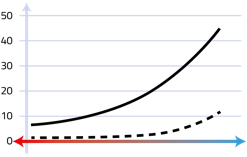When a Malaysian airliner was shot down over Ukraine in 2014, information – and disinformation – about the crash quickly spread on Twitter. Now researchers have discovered a pattern in the users who were hit most by the disinformation about the shooting-down.
On 17 July 2014 at 13:20 local time, a passenger plane was shot down in eastern Ukraine. The plane had flown over an area where there was armed conflict between soldiers deployed by the Ukrainian government and separatist groups supported by Russia. The conflict on the ground had struck the plane, but who fired the missile that killed nearly 300 innocent people? This was the subject of a storm of tweets in the following hours, days and months.
Today we know with great certainty that the plane was shot down by a BUK missile shipped to Ukraine from the 53rd anti-aircraft brigade in Kursk in Russia.
This was the conclusion of a large Dutch-led inquiry back in 2016, and at a recent press conference they set out their findings and formally identified the Russian state as the party behind the shooting-down. Russia refuses to be involved.
The Twitter debate on the downing of the plane – Malaysia Airlines flight 17 or MH17 – is a good example of how information, misinformation and disinformation spread on social media.
Professor Rebecca Adler-Nissen and her colleague Associate Professor Frederik Hjorth, of the Department of Political Science at the University of Copenhagen, worked intensively on this subject. Adler-Nissen heads the research project “Digital Disinformation”, which examined a selection from the many millions of tweets about what happened to MH17.
In one specific analysis Hjorth and Adler-Nissen look at how disinformation moves through the network of Twitter users and which users are hit most.
The analysis, which Frederik Hjorth and Rebecca Adler-Nissen described in a recent article in the Danish newspaper Politiken, is based on information from more than 8,000 US Twitter users, who all tweeted about the crash, and their 12.5 million plus followers.
The researchers chose American profiles, because it is possible to obtain very detailed knowledge about them. In the analysis, the researchers grouped tweets about the crash into pro-Russian, pro-Ukrainian and neutral statements, and grouped Twitter users according to their political beliefs, measured, for example, by the political opinion-formers that they follow.
And the connection is clear: The more right-wing a user is, the greater the likelihood that he or she has been exposed to pro-Russian disinformation about MH17 crash.
08.33
The more right-wing a user is, the greater the likelihood that he or she has been exposed to pro-Russian disinformation.
The probability of following an account on Twitter which spreads pro-Russian disinformation (in general and about the crash in 2014)

PROBABILITY OF EXPOSURE TO INFORMATION (%).
Proportion of all information on the MH17 crash which is pro-Russian disinformation.
POLITICAL CONVICTIONS
Very left-wing Twitter users
Very right-wing Twitter users
Proportion of all information that is pro-Russian disinformation.

The figure shows the proportion of users' information about the crash which may be said to be pro-Russian disinformation – and this figure is very different depending on whether the user is left- or right-wing.
In very left-wing users’ feeds, disinformation accounts for a modest 7 per cent of the information about MH17, while in very right-wing users’ feeds, it is as much as 45 per cent – or up to half of their available Twitter updates about the crash.
However, as Frederik Hjorth and Rebecca Adler-Nissen stress, it is important to remember that pro-Russian disinformation constitutes a relatively small part of Twitter activity on the downing of the plane in absolute terms.
The research thus shows that – at least in this case – there is what might be called an ideological asymmetry in the spread of misinformation on Twitter. How can this be? Frederik Hjorth explains:
“The Americans who have been most exposed to pro-Russian disinformation about the shooting are politically very far out on the right-wing – and a possible explanation for the disparity is that there is widespread scepticism about mainstream media on the American right. Our data also indicates that these users largely follow alternative news sources of various kinds, and we must assume that this is why disinformation pops up more in their feeds than in other peoples’.”
The imbalance in the spread of disinformation therefore means, says Rebecca Adler-Nissen, that some groups of citizens have a very different view of world events than the vast majority. And this makes great demands on the authorities and the media who wish to counter the disinformation with campaigns and corrections:
08.37
Some groups of citizens have a very different view of world events than the vast majority.
“The problem with correcting incorrect information on social media is that it can be very difficult to reach the people who have actually read and believed in the disinformation. They are often in completely different networks on Twitter than the people publishing the corrections,” says Rebecca Adler-Nissen.
“There is great distrust of this type of fact-checking, so even if we reach the selected group, it is far from certain that this will have the desired effect. It is a challenge that no authorities and media have solved yet.”


Rebecca Adler-Nissen and Frederick Hjorth are professor and assistant professor in the Department of Political Science at the University of Copenhagen. They are both part of the research project “Digital Disinformation”.